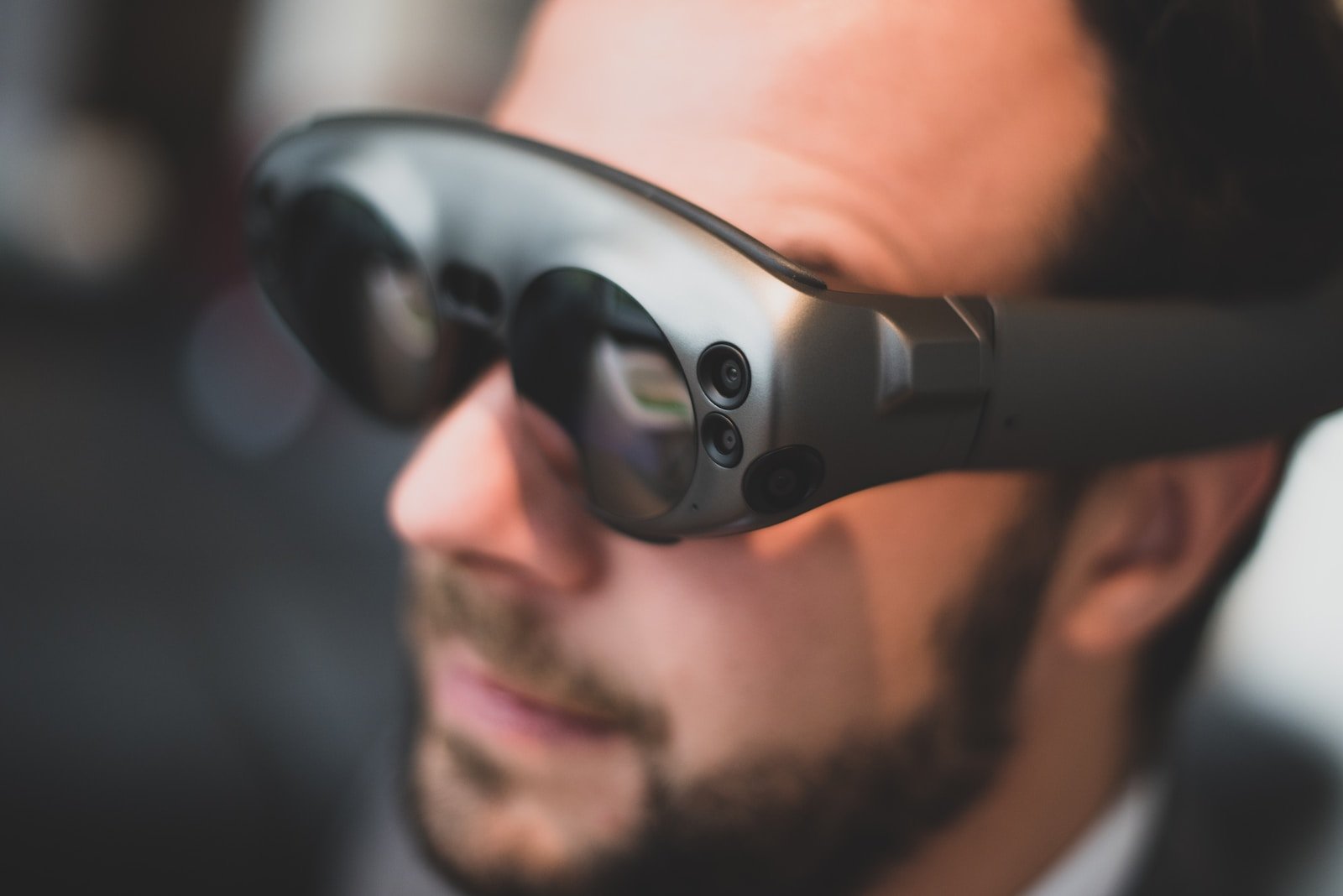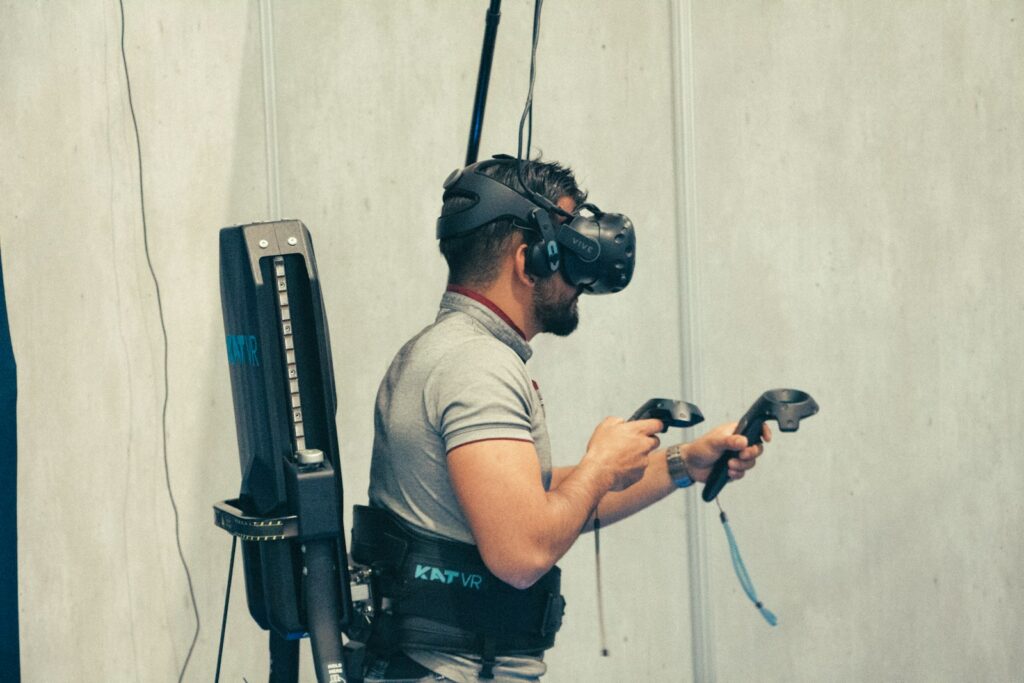In an era where technology transcends the boundaries of imagination, the quest for creating captivating experiences and increasing industry efficiency has led to the creation of immersive hardware such as Metaverse Glasses. These glasses can transport you to the virtual universe in the blink of an eye and are completely redefining our perception of reality.
In this article, we will delve deep into the fascinating realm of these groundbreaking glasses, exploring their transformative potential, cutting-edge features, and the unparalleled sensory escapades they offer.
Key points
- Metaverse Glasses are wearable technology that can provide users with immersive experiences within virtual worlds.
- These glasses use AR, VR, and MR technologies to create a seamless simulation of a metaverse environment.
- Metaverse Glasses are more lightweight and compact than headsets, providing greater freedom of movement and a less isolating experience.
- Essential features to consider when shopping for Metaverse Glasses include display quality, comfort, processing power, battery life, tracking, and interaction.
- The 5 best Metaverse Glasses in 2023 include Lenovo ThinkReality A3, Vuzix Blade Upgraded, Google Glass Enterprise 2, Magic Leap 2, and Epson Moverio BT-300.
- Pros of using metaverse glasses include enhanced connectivity, immersive experiences, and applications in education, profession, entertainment, and gaming.
- However, there are cons, such as cost, technical limitations, comfort and ergonomics, and privacy and security concerns.
- Metaverse glasses are expected to be the next logical step in accessing the metaverse and becoming the perfect AR gadget for the future, driving the defining applications of web3 and metaverse technologies.
What Are Metaverse Glasses?
Metaverse Glasses are designed to provide users with an immersive and interactive experience within the metaverse—a collaborative virtual space where digital and physical realities converge. These glasses employ a combination of advanced technologies, such as augmented reality (AR), virtual reality (VR), and mixed reality (MR), to create a seamless and vivid simulation of the metaverse environment.
Metaverse Glasses typically consist of a lightweight, ergonomic headset with built-in sensors, cameras, and displays, harmoniously overlaying digital content onto the user’s field of view. This enables users to see, hear, and interact with virtual objects and environments as if they were integral to their physical surroundings.
Difference Between Metaverse Glasses and Headsets
While both Metaverse Glasses and headsets aim to provide users with immersive experiences within the virtual world, there are some critical differences between the two in terms of design, functionality, and user experience:
- Design and form factor: Metaverse Glasses typically feature a more lightweight and compact design resembling a pair of eyeglasses or sunglasses. This makes them more comfortable to wear for extended periods and allows for greater freedom of movement. On the other hand, headsets are usually bulkier and cover the entire head, making them less comfortable and portable.
- Immersion and field of view: Headsets offer a more immersive experience by completely covering the user’s eyes and providing a wide field of view, making it feel like the user is genuinely transported into the virtual world. With their sleeker design, Metaverse Glasses may offer a slightly smaller field of view. However, they still provide complete immersion by overlaying digital content onto the user’s real-world surroundings.
- Augmented reality capabilities: Metaverse Glasses tend to emphasize the integration of digital and physical environments, using AR and MR technologies to blend virtual objects and experiences seamlessly with the real world. This allows users to stay connected to their surroundings while interacting with the metaverse. Headsets, especially those focused on VR, often prioritize complete immersion into the virtual world, which can result in a more isolating experience.
- Accessibility and ease of use: Metaverse Glasses are generally designed to be more user-friendly, emphasizing simplicity and ease of use. They can be worn with minimal setup, making them accessible to a broader range of users, including those who may not be familiar with VR technology. Headsets may require more complex setup procedures, and their bulkier design can sometimes be intimidating or off-putting for new users.
Metaverse Glasses Features To Look For
When shopping for Metaverse glasses, there are several key features to consider to make an informed decision and find the correct device to meet your needs. Here is a list of essential Metaverse glasses features to look for:
- Display Quality: High-resolution displays with a wide field of view are crucial for an immersive experience. Look for glasses with sharp image quality, vibrant colors, and excellent contrast ratios to ensure an enjoyable visual experience.
- Comfort and Fit: Ergonomic design and adjustable components are essential for comfort during extended use. Look for lightweight glasses with adjustable nose pads and temple tips to ensure a comfortable and secure fit.
- Processing Power: A powerful processor is necessary for smooth, lag-free performance in AR, VR, and MR applications. Opt for devices with powerful processors and sufficient memory to handle complex tasks and maintain responsiveness.
- Battery Life: Long battery life is essential for uninterrupted use, especially during extended sessions. Look for glasses with efficient power management and, ideally, an option for external battery packs or charging cases for extended use.
- Tracking and Interaction: Accurate tracking of head and hand movements is crucial for a seamless and intuitive experience. Look for glasses with high-quality sensors, cameras, and hand-tracking capabilities to enable natural interactions with the virtual environment.
5 Best Metaverse Glasses in 2023
Whether you’re a seasoned explorer of virtual worlds or a newcomer eager to dive into the metaverse, these unique glasses will elevate your journey beyond the confines of reality and into the boundless expanse of the digital cosmos. So, without further ado, let’s unveil the remarkable devices reshaping our perception of what’s possible in the virtual universe.
Lenovo ThinkReality A3
The Lenovo ThinkReality A3 is a versatile, enterprise-focused smart glasses device that enhances productivity and workplace efficiency. Featuring a compact and lightweight design, these smart glasses provide a comfortable augmented reality experience while offering a range of applications for various industries, such as manufacturing, healthcare, and logistics.
Equipped with a 1080p resolution display per eye, the ThinkReality A3 delivers crisp and clear visuals, enabling users to view digital information and 3D models seamlessly overlaid onto their real-world environment. Powered by a Qualcomm Snapdragon XR1 processor, the device ensures smooth performance for demanding applications.
The A3 also includes dual 8MP cameras for precise tracking and a 13MP RGB camera for capturing high-quality images and videos. The ThinkReality A3 can easily connect to a compatible PC or select Motorola smartphones with USB-C connectivity. It provides users with a wide range of use cases and flexibility in various work settings. The glasses are currently priced at $1,499 and available on the Lenovo official store.
Vuzix Blade Upgraded
The Vuzix Blade Upgraded is a state-of-the-art smart glasses device that seamlessly integrates digital information into the wearer’s field of view. Building upon the foundation laid by the original Vuzix Blade, the upgraded version offers enhanced functionality, design improvements, and an even more immersive user experience.
Equipped with a full-color, see-through waveguide display, the Vuzix Blade Upgraded presents crisp images with a 480 x 854 pixels resolution. The device’s advanced display technology allows users to access essential information, notifications, and applications without obstructing their view of the real world. The Blade Upgraded’s integrated 8 MP camera captures high-quality photos and videos, while its noise-canceling microphones enable clear voice commands and communication.
Powered by a quad-core ARM processor and 4GB of RAM, the Vuzix Blade Upgraded ensures smooth performance and efficient multitasking. With 32GB of internal storage, users can conveniently store apps, media, and data directly on the device. The Blade Upgraded also has built-in GPS, Wi-Fi, and Bluetooth connectivity, making it easy to pair with smartphones and other devices for seamless integration. The glasses are currently priced at $1,000 and can be purchased from the Vuzix official store.
Google Glass Enterprise 2
The Google Glass Enterprise Edition 2 is a refined and powerful smart glasses device designed specifically for enterprise applications to enhance workplace efficiency and productivity. Moreover, building on the foundation of the original Google Glass, the Enterprise Edition 2 offers significant improvements in terms of performance, battery life, and overall user experience. As a result, it has become an ideal tool for industries such as manufacturing, logistics, and healthcare. Furthermore, these enhancements have made the Enterprise Edition 2 even more suitable for demanding professional use, providing increased efficiency and productivity in various work environments.
Featuring a high-resolution 640 x 360-pixel display, the Google Glass Enterprise Edition 2 provides users easy access to critical information without obstructing their field of view. The device is powered by a Qualcomm Snapdragon XR1 processor, ensuring smooth performance for various applications, and boasts an 8MP camera for capturing images and videos.
The smart glasses also have a USB-C port for fast charging, a three-beamforming microphone array for enhanced voice recognition, and Wi-Fi and Bluetooth connectivity support. The lightweight, ergonomic design and durable construction make the Google Glass Enterprise Edition 2 a practical and reliable tool for various professional settings. The glasses are currently priced at $1,000 for the base version, and users can also purchase a developer kit separately.
Magic Leap 2
The Magic Leap 2 is a groundbreaking mixed-reality device that employs proprietary Lightfield technology to create vivid, lifelike images by projecting digital light onto the user’s retina. With a 1440 x 1760 resolution per eye, this device offers a seamless and immersive viewing experience. The advanced sensors, cameras, and gesture recognition system precisely track the user’s position, head movements, and interactions, ensuring accurate placement and interaction with digital content in the physical environment.
The Magic Leap 2 is intended to execute complicated enterprise-scale programs and hold multimedia information. It has a AMD 7nm Quad x86-64 core CPU, 16 gigabytes of random access memory (RAM), and 256 gigabytes of storage. The headset is currently priced at $3,299.
Epson Moverio BT-300
The Epson Moverio BT-300 is an innovative pair of smart glasses that have garnered attention for their cutting-edge design and impressive augmented reality (AR) capabilities. As a pioneer in AR, the Moverio BT-300 combines Epson’s advanced display technology with a sleek and lightweight form factor, making it an appealing choice for users seeking to explore the metaverse with style and comfort.
With a focus on delivering high-quality visuals, excellent performance, and ease of use, these glasses are a testament to Epson’s commitment to pushing the boundaries of wearable technology.
Its powerful display technology lies at the core of the Moverio BT-300’s success. Epson employs its proprietary silicon-based OLED (Organic Light Emitting Diode) microdisplay, which offers a high-resolution image (1280×720 pixels), bright colors, and an enhanced contrast ratio. This results in crisp, clear visuals that bring the metaverse to life.
Moreover, the glasses have a 5-megapixel front-facing camera, enabling users to capture images and videos while interacting with the digital world. Powered by a quad-core Intel Atom X5 processor, the BT-300 ensures a smooth and responsive AR experience.
The Moverio BT-300’s design is another aspect that sets it apart from the competition. Weighing just 2.5 ounces (69 grams), these smart glasses are remarkably lightweight and comfortable, making them ideal for extended use. AR enthusiasts can purchase these glasses for $899 on Epson’s marketplace.
Pros and Cons of Using Metaverse Glasses
As with any emerging technology, there are pros and cons to using metaverse glasses, which potential users should consider before diving into this new realm.
Pros:
- Enhanced Connectivity: Metaverse glasses enable users to interact with digital content in real-time, offering opportunities for communication, collaboration, and social networking on a whole new level.
- Immersive Experiences: By integrating AR, VR, and MR technologies, metaverse glasses provide users with highly immersive experiences, allowing them to engage with virtual environments and digital objects in more realistic and interactive ways.
- Educational and Professional Applications: Metaverse glasses can be used for various academic and professional purposes, including remote learning, virtual training, and simulations, significantly enhancing learning outcomes and skill development.
- Entertainment and Gaming: The immersive nature of metaverse glasses allows for more engaging and interactive entertainment and gaming experiences, providing users with a new level of excitement and enjoyment.

Credit: https://www.vitatanden.se/
Cons:
- Cost: Metaverse glasses can be relatively expensive, especially for high-end models, which may make them inaccessible to some potential users.
- Technical Limitations: Some metaverse glasses may have limited battery life, field of view, or image quality, impacting the overall user experience.
- Comfort and Ergonomics: Depending on the design, some metaverse glasses may not be comfortable to wear for extended periods, leading to potential discomfort or fatigue for users.
- Privacy and Security Concerns: As metaverse glasses collect and transmit data, there are potential privacy and security risks associated with their use, leaving users vulnerable to data breaches or unwanted surveillance.
Are Metaverse Glasses Perfect AR Devices?
Metaverse glasses are often regarded as the ideal AR gadget, providing a simplified and user-friendly means of bringing diverse concepts to life. Since AR experiences revolve around converging virtual elements with real-life surroundings, Metaverse glasses enable users to comfortably walk around and incorporate them into their daily lives without wearing bulky headsets. While they are not currently readily accessible primarily to their high prices, we expect to see several consumer-level Metaverse glasses in the near future.
Conclusion
In conclusion, metaverse glasses are rapidly improving, providing users with various devices that enable seamless interactions within virtual universes. As technology evolves, we can expect more sophisticated devices with improved features and applications, further blurring the lines between the digital and physical worlds. The metaverse glasses are not only changing the way we perceive reality and opening up new opportunities for social interaction, entertainment, education, and economic growth.
FAQs
How do metaverse glasses facilitate social interaction within virtual spaces?
Metaverse glasses facilitate social interaction within virtual spaces by providing users with an immersive and connected experience. These glasses enable users to access shared virtual environments where they can interact with other users in real-time, either through avatars or as themselves. Features like spatial audio, gesture recognition, and eye-tracking allow for more realistic and engaging communication.
What are the potential applications of metaverse glasses across various industries, such as education, entertainment, and healthcare?
Metaverse glasses have numerous potential applications across a wide range of industries. They can provide immersive learning experiences in education, allowing students to explore virtual environments, interact with 3D models, and engage in simulations. For entertainment, metaverse glasses can enhance gaming experiences, offer access to virtual concerts and events, and create new forms of storytelling. Healthcare providers can use Metaverse glasses for remote consultations, medical training, and virtual rehabilitation programs. Similarly, in industry, metaverse glasses are beginning to transform manufacturing processes enabling workplace employees to mitigate against mistakes, increasing efficiency and production.
Can metaverse glasses replace smartphones and other existing devices in the future?
While it’s difficult to predict with certainty, metaverse glasses can definitely replace or complement smartphones and other devices in the future. As technology advances and becomes more integrated into our daily lives, metaverse glasses could serve as a primary device for communication, information access, and digital interaction.
References
10 BEST Augmented Reality Glasses (Smart Glasses) In 2023
Best AR Glasses to Look Out for in 2023 and Beyond
Best smart glasses 2023: Our top picks
The 4 best AR glasses: Pro-level AR and XR headsets


















